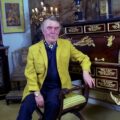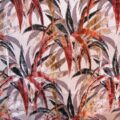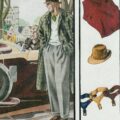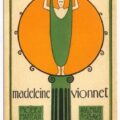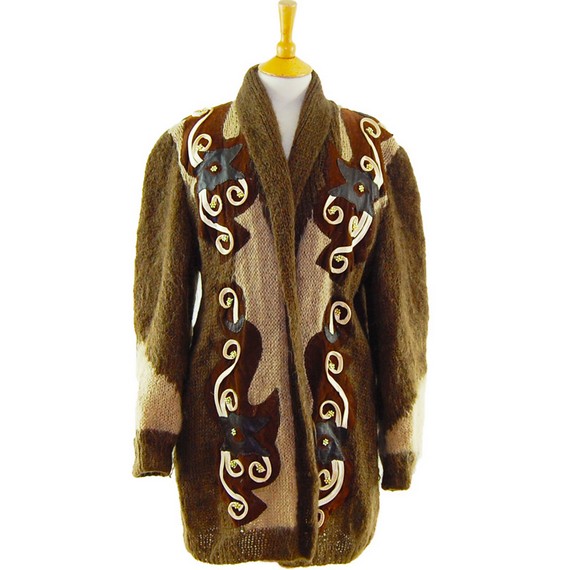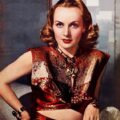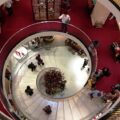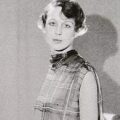Peter Russell, the Rubber Plant Farmer Turned Couturier
February 11, 2020Peter Russell is someone you don’t really hear about now, but he was in all the press between 1932 and 1952. He was a British couturier based in Mayfair. His work is all about complicated pleats, tailoring, mysterious colours and inventive fabrics.
There was also a whiff of mystery and faint scandal to the man himself, who was known as “outspoken and highly strung”. His dresses are stunning, and two of them now reside in the V&A Museum.

Evening dress and petticoat by Peter Russell 1935-1937. Image via Pinterest.

Evening Dress by Peter Russell, 1945. Note the use of fishnet. Image via Pinterest.

Day dress by Peter Russell, 1946. Photo by Cecil Beaton. Image Pinterest.

Evening dress by Peter Russell, 1951. Photo by Norman Parkinson, image via Pinterest.

Afternoon dress for Ascot by Peter Russell. Drawn for The Lady , 1953-54. Image via Pinterest.

Marcel Fromenti. Afternoon coat and dress ensemble by Peter Russell drawn for The Lady. 1953-54. Image via Pinterest.

Peter Russell 1953. Photo Norman Parkinson. Image via Pinterest.
Peter Russell, the farmer?
Peter Russell was born Thomas Christmas Russell in rural Norfolk, UK, in 1886. His mother was in service. There isn’t much out there about his background but it might have been in farming, because of his location and the fact that in 1909, at the age of 23, he moved to Canada to be a farm hand. Newspaper reports also have him as a horse rancher there, which sounds a little more glamorous.
But newspaper reports, based on his own stories, are not very accurate because also according to them he was entirely self taught by studying fashion illustrations in Vogue. However, he actually worked for a costume designer in 1913, before being called up for war service. He was invalided out and returned to the UK in 1915. On his return, he married Caroline Hilda Onions in 1918 but moved to Malaya (now Malaysia) the same year without her. The marriage was later annulled. In Malaya he worked as a rubber planter. His personal myth says he now found his metier when he helped the wife of a fellow planter create a ball gown for the Government House Ball.
Peter Russell of Peter’s Studio
In 1930, he was back in England and had taken the name Peter. His London dressmaking business was in Park Road, a good address, and called ‘Peter Russell of Peter’s Studio”. The year after that he moved to Bruton Street, which was a very prestigious address. By 1934, he also had a salon in Paris. In 1937 he settled in Carlos Place, Mayfair.
It’s hard to know how a person with a farming background, however talented, managed to set up a couture business alongside London’s elite. Generally, you need connections and a lot of money. He told the newspapers he had only £20 in his pocket on his return to England. It’s possible that his mother gave him an introduction to society because she was a lady’s maid, but that probably only happens in Downton Abbey. It is known that the silent movie actress Faith Bevan invested initially, but she actually put a notice in the Times to dissociate herself from him in 1933.
It’s fascinating. He was certainly a big character, and perhaps charmed his way into society and the money, only to really annoy people later on. One of his clients, the opera singer Ruth Vincent did not want to be dressed by him any more and defected to Norman Hartnell because of his “Uneven temper”. He was also described as “macho”.
The Opinionated Designer
He provided the commentary to his own catwalk shows, the only designer to do so at the time. His style was not the usual dry description of materials and cut but entertaining, witty and sometimes outrageous. “Turning the girls this way and that if necessary, and generally explaining down to the last button just what goes to make a Peter Russell model. He practically never stops talking, but his monologue is refreshing, interesting and ceaselessly patterned with that indestructible self-assurance of the super-craftsman,” as it was described at the time.
Press interviews and personal accounts show him as opinionated and even confrontational, but it obviously made good copy. Just one example is when he said: “Dior‘s short hemline is a stunt – most women want simple, elegant clothes with just a touch of intrigue”.
As Much at Home in the Saddle as the Salon
He was keen on outdoor sports and said that he was “as much at home in the saddle as the salon”. His personal appearance was described as shabby (he preferred to call it “elegant disarray”). Which is also strange because in the 1950s he started advocating a return to Edwardian-style dress for men. He demonstrated by wearing stovepipe trousers, a red cummerbund and matching carnation for one of his fashion shows in Melbourne.
But it seemed that his work outshone his personal limitations. Russell’s attention to detail meant that shoes, hats and gloves were chosen alongside the fabric for his clothes, which was often dyed, printed or even woven to his specification. His method of working was to come up with an idea and then sketch it out over and over until he had the perfect creation.
His speciality was elegant and practical haute couture clothes, particularly daytime separates. The tailoring was particularly celebrated. Although the tailoring was refined, he used interesting fabrics, such as “tweed chiffon” and “Aerophane”. He also did not shy away from innovation, as he also employed permanently pleated artificial silk (the pleating was done by a specialised outside firm to his specifications) and clear nylon zippers, a new invention of the time.
INCSOC and the Second World War
During the Second World War, Russell was a very vocal member of the board of the Incorporated Society of London Fashion Designers (the British version of the Chambre Syndicale de la Haute Couture in Paris). He also designed beautiful utility clothing.
Australia
In the late 1940s, Russell was invited to show his collection in an upmarket department store in Melbourne, Australia. He continued to work with them and in August 1953 sold his business in England, packed up and moved there. He was to work in an advisory capacity to fashion fabrics mills. However, in November that year he suddenly moved back to England and retired.
Peter Russell died in Folkestone in 1966.



